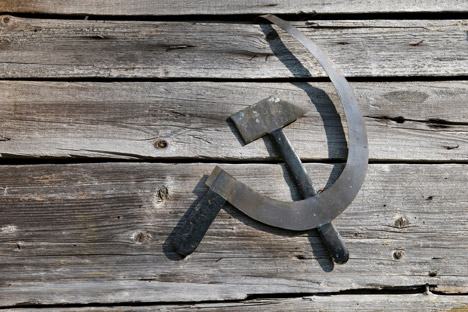Mystical emblem: The secrets of the hammer and sickle

The hammer and sickle stands for worker-peasant alliance: the hammer is a traditional symbol of proletariat and the sickle is a traditional symbol for the peasantry. Source: Lori / Legion Media
The hammer and sickle that decorated the coat of arms of the USSR is probably the most recognizable symbol both of Soviet power and of the ideology of the state
The origin of the Soviet coat of arms is ambiguous. Several variants were initially worked out: a hammer and sickle, a hammer and rakes, a hammer and pitchforks, and a hammer and plow. The hammer was chosen for its traditional association with workers in European countries.
Together with an agricultural tool, it was supposed to illustrate Lenin’s famous slogan about the unity of the proletariat and peasants.
In April 1918 the final version of the emblem was approved – a design by the Moscow artist Yevgeny Kamzolkin. In summer 1918 the Fifth Session of Soviets officially adopted the symbol.
It is interesting to note that Kamzolkin was not even a communist and, furthermore, he was a deeply religious man from a wealthy family. The artist was a member of the mystical artistic Society of Leonardo da Vinci for more than 10 years and perfectly understood the meaning of the symbols.
First of all, the hammer and sickle are associated with the Masonic symbol of the hammer and chisel. These items signified a clearly defined goal (chisel) and its firm manifestation (hammer). In European religious symbology, the hammer is associated with aggressive male force, physical (the hammer of the blacksmith Hephaestus in Greece) as well as deadly.
The thunder gods Svarog (Slavic) and Thor (Norse) wielded it in their hands. In China and
It is now difficult to say what meanings Kamzolkin insinuated into his drawing. Was he solely carrying out the order to create an image for the alliance of peasants and workers, or did he infuse into this symbol his attitude towards revolutionary power, choosing symbols for death, war, and the triumph of evil?
The Russian philosopher Alexei Losev gave the following assessment of the crest: “It is a symbol that propels the masses and is not merely a symbol but is a constructive-technical principle for human actions and volitions … Here we see the symbol of the unity of the workers and peasants, the symbol of the Soviet state.”
The historian and academician Yury Gauthier wrote in 1921 in his diary: “A sharpness has pervaded Moscow for several days: How will it end? The answer will be in the words “hammer, sickle” read in reverse!” The fact is that it sounds like “with a throne” [put together and inversed, the words for hammer (
In various religions, the sickle is interpreted as a symbol of death. In Christianity, the sheaves and the harvest are equated with the human souls that the Harvester, i.e. the Lord, will gather after the end of the world. It is interesting to note that during the Middle Ages death was depicted not with a scythe but specifically with a sickle.
The pagan pantheons of various Indo-European and Slavic peoples feature a goddess called Mara or Morana, who traditionally held a sickle in her left hand. In
Curiously, the eagle on the coat of arms of revolutionary Austria also holds a sickle in its left claw and the sickle is likewise placed on that side on the Soviet crest.
The name “Hammer and Sickle” has been given to numerous settlements, villages, and railway platforms on the territory of modern Russia, Ukraine, Belarus, and
There even used to be a special
All rights reserved by Rossiyskaya Gazeta.
Subscribe
to our newsletter!
Get the week's best stories straight to your inbox